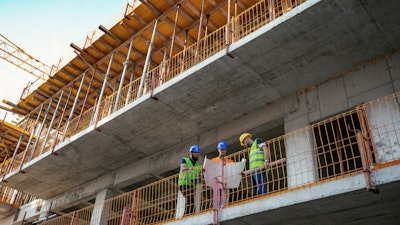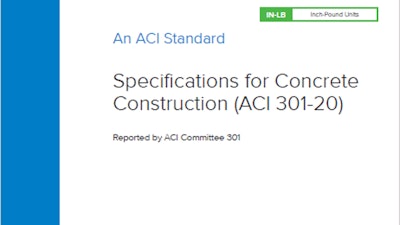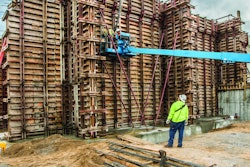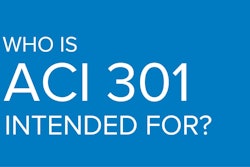
ACI 301-20: “Specifications for Concrete Construction,” published by the American Concrete Institute (ACI), sets forth criteria for concrete construction that guide contractors in their daily work. The specification is commonly incorporated by reference into contract documents by the architect or engineer (A/E). Requirements set forth in ACI 301-20 meet the minimum requirements in ACI 318-19 “Building Code Requirements for Structural Concrete.”
 The ACI 301-20, Specifications for Concrete Construction, has been expanded to include shotcrete, internal curing, mineral fillers, and recycled concrete aggregates. Evaluation requirements for concrete made with self-consolidating concrete and structures designed for modulus of elasticity were also included in the update. Compliance details throughout ACI 301-20 have been updated to align with ACI 318-19.American Concrete Institute
The ACI 301-20, Specifications for Concrete Construction, has been expanded to include shotcrete, internal curing, mineral fillers, and recycled concrete aggregates. Evaluation requirements for concrete made with self-consolidating concrete and structures designed for modulus of elasticity were also included in the update. Compliance details throughout ACI 301-20 have been updated to align with ACI 318-19.American Concrete Institute
Two checklists for incorporating ACI 301 into concrete specifications are included. The first of these checklists indicates specific qualities, procedures, and performance criteria that the specifier must include in a project specification that are not defined in ACI 301-20, while the second checklist identifies choices and alternatives that the specifier can include as requirements in a specification.
ACI also released MNL-15(20): “Field Reference Manual.” On any project where ACI 301 is specified, it is required that the contractor keep a copy of this manual in the field office. The new Field Reference Manual includes ACI 301-20 along with more than 20 selected reference documents that are needed to complete specifications including references on formwork; measuring, mixing, transporting, and placing concrete; concrete pumping methods; consolidation; and hot and cold weather concreting.
 The number of individuals earning their ACI Certification continues to grow. Here, you can see adhesive anchor installation testing in progress.American Concrete Institute
The number of individuals earning their ACI Certification continues to grow. Here, you can see adhesive anchor installation testing in progress.American Concrete Institute
What’s New
Section 1—General Requirements:
- New definitions were added for clarity. Definitions of specialty concrete applications covered in separate sections were removed.
- Optional requirements include a preconstruction conference to review project requirements, acceptance criteria, and responsibilities.
- Shotcrete is now included in the scope.
Section 3—Reinforcement and Reinforcement Support:
- Zinc-coated (galvanized) reinforcing bars for structures designed in accordance with ACI 318-19 must still conform to ASTM A767/A767M. However, zinc-coated reinforcement conforming to ASTM A1094/A1094M may now be specified for applications where a lesser zinc coating thickness is permitted.
Section 4—Concrete Mixtures:
- Requirements for slump flow of self-consolidating concrete (SCC) were separated from slump requirements for other concrete mixtures. Also, if specified, passing ability and static segregation should be evaluated in accordance with ASTM C 1621 and ASTM C1610, respectively.
- Minimum cementitious materials requirements for floors were removed, providing more flexibility in designing concrete mixtures.
- Timelines for the prequalification of aggregates were extended. Data on types, sizes, pit or quarry locations, producers’ names, aggregate supplier statement of compliance with ASTM C33, and ASTM C1293 expansion data must be no more than 24 months old.
- Crushed hydraulic-cement concrete or recycled aggregate may be permitted if documentation is provided as required by the A/E and its use is determined suitable for a particular project.
- Mineral fillers, conforming to ASTM C1797, are now permitted provided they are obtained from the same sources and consist of the same types as those used in concrete represented by submitted field test records or used in trial mixtures.
- If Modulus of Elasticity is specified, test data for proposed mixtures must be submitted. The average of at least three cylinders from the same concrete sample, tested at 28 days, must meet or exceed the specified value.
- Lightweight aggregate for internal curing is limited to prewetted fine aggregate conforming to ASTM C1761.
- Aggregates determined to be susceptible to alkali-carbonate reactions per ASTM C1778 testing are not allowed.
- Limitations imposed on concrete mixtures to be qualified to reduce the potential of alkali-silica reactivity were revised; adding a requirement for submitting supporting data for each aggregate showing expansion in excess of 0.10 percent at 16 days when tested in accordance with ASTM C1260, and defining limits for expansion and alkali content based on level of aggregate reactivity.
- Requirements for sulfate exposure categories were updated to match the requirements of 318-19.
- For stay-in-place galvanized steel forms, the maximum chloride content must comply with Exposure Class C1 limits. Compliance with specified chloride ion limits can be verified using the water-soluble chloride ion content or the total chloride content.
Section 5—Handling, Placing, and Constructing:
- For cold weather placements, unless otherwise specified, metallic items in concrete formwork must be above 10˚F, and contact surface temperature of ground, subbase, or mud mats has to be above 32˚F.
- For integrating high-strength concrete with floor systems, high-strength concrete should extend through the full floor system depth at least 2 feet past each face of columns and walls to achieve a monolithic mass.
- Surface finish SF-2 is now established as the default formed finish. Language defining concrete exposed to view has been revised. Color, texture, and bughole requirements have been clarified, and rubbed and other finish requirements have been updated.
- When curing by ponding, the temperature of ponding water must be at least 50˚F and not more than 35˚F cooler than the surface temperature of the concrete at the time the water and concrete come in contact.
- Adhesive anchor holes that are horizontally or upwardly inclined and are designated in the contract documents to support sustained tension must be installed by manufacturer’s instructions by personnel who are certified by ACI’s Adhesive Anchor Installer Certification Program or other accepted equivalent programs.
Section 6—Architectural Concrete:
- Formwork must be a structurally rated plywood with a nonporous finished surface, bonded to a sanded hardwood veneer substrate unless otherwise specified.
Section 8—Mass Concrete:
- Material restrictions for specific types of cementitious materials were removed and allowance was made for permissible changes to materials that do not require updates to the thermal control plan. Materials are now to be specified by the designer or default to cementitious materials specified in Section 4.
Section 9—Post-Tensioned Concrete:
- The term “bonded post-tensioning” has been revised to “grouted post-tensioning.” The change in terminology aligns with PTI Multistrand and Grouted Post-Tensioning certification programs.
- Non-encapsulated tendons are prohibited in slabs-on-ground that are exposed to external sources of chlorides from deicing chemicals, salt, brackish water, seawater, or spray from these sources. They are also prohibited where stressing pockets are subject to wetting or direct contact with soil during service.
- Excess lengths of tendons beyond encapsulated anchorages must be removed to ensure proper fit of encapsulation cap. Cutting of tendons should not damage wedges or compromise the encapsulation system.
Section 11—Industrial Floor Slabs:
- Joint fillers must have 100 percent solids content and Shore A hardness requirements of at least 85 when measured in accordance with ASTM D2240 and an elongation below 90 percent when measured in accordance with ASTM D638.
Section 12—Tilt-Up Concrete:
- The A/E may specify an alternative type of smooth panel finish other than the typical SPF-2 based on normal intended service. The wording has been revised to clarify each recommended classification based on the visibility of panels.
- A smooth panel finish of SPF-3 requires the preparation of mockup panels.
Section 13—Precast Structural Concrete & Section 14—Precast Architectural Concrete:
- Fabricator qualifications include optional requirements for an alternative certification program from the National Precast Concrete Association (NPCA) applicable to some structural precast concrete products, except those that are prestressed.
The new ACI 301 provides the latest construction practices and concrete-related material information necessary for today’s contract documents. If contractors and other industry personnel are not well-versed in the changes incorporated in ACI 301-20 it can have a negative impact on a project’s budget and schedule.
ACI Specifications for Concrete Construction and the ACI Field Reference Manual are both available in printed and digital formats.
About the author
Michelle L. Wilson is Senior Director, Cement and Concrete Technology, Portland Cement Association and Chair of ACI Committee 301 during the 2016-2020 document cycle.



















